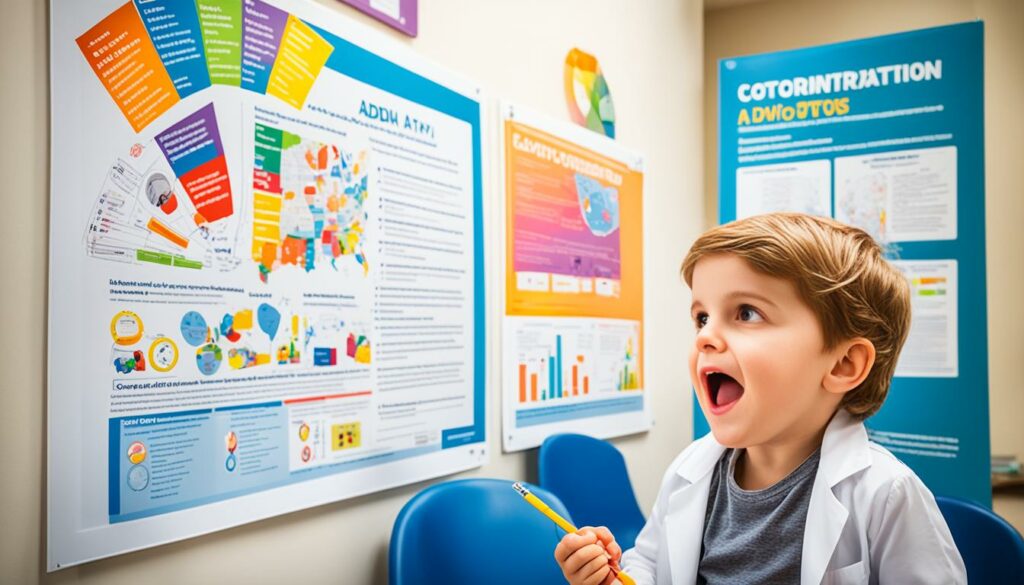ADHD, or Attention-Deficit/Hyperactivity Disorder, is a common neurodevelopmental disorder that affects both children and adults. But when can ADHD be diagnosed? Is there an age limit or a specific timeline? The answer to this question is crucial for early detection and intervention, which can significantly impact a child’s development and long-term outcomes.
Many parents and caregivers wonder when they should start considering the possibility of ADHD in their child. Is it normal for a toddler to have trouble focusing? Should preschool-age behavior be a cause for concern? These questions reflect the challenges faced in diagnosing ADHD in young children.
In this article, I will explore the timeline for diagnosing ADHD, the importance of early detection, and the available intervention strategies. We will also delve into the challenges of diagnosing ADHD in preschoolers and the factors that healthcare providers consider during the assessment process.
Join me on this journey as we uncover the mysteries of ADHD diagnosis and the benefits of early intervention. Let’s challenge our assumptions and explore the world of ADHD from a new perspective.
Key Takeaways:
- The American Academy of Pediatrics recommends assessing ADHD in children from 4 years of age onwards.
- Diagnosing ADHD in preschoolers can be challenging due to the overlap of symptoms with typical behavior at that age.
- Early intervention is crucial for preschool children with ADHD to prevent behavior problems and improve academic functioning.
- Behavioral parent training is the recommended treatment for preschool children with ADHD.
- Early detection and intervention can lead to better long-term outcomes for children with ADHD.
Signs of ADHD in Children: Recognizing the Symptoms
ADHD, or Attention-Deficit/Hyperactivity Disorder, is a neurodevelopmental disorder that affects children and can continue into adulthood. It is important to recognize the signs and symptoms of ADHD to get the appropriate help and support for affected children.
Children with ADHD may exhibit a combination of inattentive, hyperactive, and impulsive behaviors. Here are some common signs to look out for:
- Inattention: Children with ADHD may struggle to pay attention, easily get distracted, have difficulty following instructions, and often forget or lose things.
- Hyperactivity: They may seem excessively active, have difficulty staying seated, fidget or squirm, and always be “on the go.”
- Impulsivity: Impulsive behaviors can include interrupting others, blurting out answers, difficulty waiting for their turn, and acting without considering consequences.
It is important to note that many of these behaviors can be typical for children. However, for a diagnosis of ADHD, the symptoms must be severe, persistent, and present in multiple settings, such as home and school. The symptoms must also have been ongoing for at least six months.
I always thought my child’s behavior was just typical for their age, but after learning about the signs of ADHD, I realized there might be something more going on. Seeking professional help and understanding the symptoms is essential for early intervention and support.
If you suspect that your child may have ADHD, it is recommended to consult with a healthcare professional who specializes in neurodevelopmental disorders. They can provide a thorough evaluation and determine the most appropriate course of action.
| Signs of ADHD | Description |
|---|---|
| Inattention | Difficulty paying attention, following instructions, and staying organized |
| Hyperactivity | Excessive activity, restlessness, and difficulty staying seated |
| Impulsivity | Interrupting others, impulsive behavior, and difficulty waiting |
Diagnosing ADHD in Preschoolers: Challenges and Considerations

Diagnosing ADHD in preschoolers can be particularly challenging due to the overlap of ADHD symptoms with normal behavior at that age. It requires careful consideration of various factors and evaluation methods to reach an accurate diagnosis. When diagnosing ADHD in preschoolers, evaluators must have a deep understanding of the clinical, cognitive, behavioral, neurofunctional, and neuropsychological nuances of the disorder.
One of the challenges is determining the severity and persistence of the behaviors exhibited by the child. While some behaviors might be common at this age, it is crucial to differentiate between typical behavior and ADHD symptoms that significantly impact the child’s daily functioning and academic performance.
Various assessment methods can be valuable in diagnosing ADHD in preschoolers. These include parental reports, behavior observation, and structured instruments. Parental reports provide essential insights into the child’s behavior in different settings and environments. Behavioral observation allows professionals to witness the child’s behavior firsthand. Structured instruments, such as rating scales and questionnaires, facilitate a more systematic evaluation of symptoms. However, it is important to note that these assessments can be subjective and require expertise and careful interpretation to distinguish ADHD symptoms from typical behavior.
Key Considerations:
- Severity and persistence of symptoms
- Impact on daily functioning and academic performance
- Expertise in clinical, cognitive, behavioral, neurofunctional, and neuropsychological aspects
- Parental reports, behavior observation, and structured instruments
- Subjectivity and careful interpretation of assessments
Evaluating Symptoms in Preschoolers
Diagnosing ADHD in preschoolers requires a comprehensive evaluation and proper understanding of the child’s behavior and its impact on their daily life. It is essential to involve professionals with expertise in different aspects of the disorder, as well as consider multiple assessment methods for a more accurate diagnosis.
| Challenges | Considerations |
|---|---|
| Overlap of symptoms with normal behavior | Evaluate severity and persistence of behaviors |
| Subjectivity of assessments | Require expertise and careful interpretation |
| Impact on daily functioning and academic performance | Differentiate between typical and ADHD-related behaviors |
Early Detection of ADHD: Benefits and Importance

Early detection of ADHD plays a crucial role in ensuring timely intervention and improving long-term outcomes. Research has shown that identifying ADHD early on can lead to a reduction in its core symptoms and their medium- and long-term effects.This has a significant impact on a child’s overall well-being and future success.
By detecting ADHD early, parents are able to become more aware of their child’s needs and provide the necessary support and understanding. This awareness allows parents to implement strategies and interventions that cater to their child’s strengths and help them overcome their weaknesses, setting them on a path toward academic and social success.
Early treatment interventions, such as behavioral and parenting techniques, have been shown to significantly benefit preschoolers with ADHD. These interventions can promote positive behavior, improve attention and focus, and enhance overall functioning in academic settings and social interactions.
Moreover, early detection serves as a valuable opportunity for educators and healthcare professionals to collaborate and develop tailored intervention plans that address the unique needs of each child. Teachers can implement classroom strategies and accommodations that support the child’s learning style and promote their success. Collaborative efforts between parents, educators, and healthcare providers set the stage for a comprehensive and holistic approach to managing ADHD in preschoolers.
Ultimately, early detection of ADHD not only ensures that children receive the support they need from an early age but also increases their chances of reaching their full potential. By addressing the challenges of ADHD in its early stages, children can develop the skills and coping mechanisms necessary to navigate their academic and social environments successfully.
ADHD Diagnosis in Young Children: Age Considerations

When it comes to diagnosing ADHD in young children, age considerations play a crucial role. The American Academy of Pediatrics recommends assessing ADHD in children from 4 years of age onwards. However, diagnosing ADHD in children younger than two is often met with hesitation among experts. Although there have been cases of ADHD diagnosis in children under four, children between the ages of three and four present unique challenges in the diagnostic process.
The Diagnostic and Statistical Manual of Mental Disorders (DSM-5) criteria for ADHD may not provide enough specificity to aid in the diagnosis of preschoolers. Instead, evaluators must rely on multiple assessment methods, including clinical judgment and observations of behavior in various settings.
Diagnosing ADHD in young children requires careful consideration of age-related factors, as symptoms can manifest differently at different stages of development. By taking into account age considerations and using comprehensive assessment approaches, healthcare providers can improve the accuracy of ADHD diagnoses in young children.
“Diagnosing ADHD in young children requires an understanding of their developmental stage and the nuances of their behaviors. By considering age-related factors and combining different assessment methods, we can make more accurate diagnoses and provide appropriate support for these children.”
– Dr. Lisa Johnson, Child Psychologist
Diagnostic Challenges
The diagnostic process for ADHD becomes more complex as children reach the ages of three and four. At this stage, typical developmental behaviors may overlap with symptoms of ADHD, making it harder to differentiate between the two. Evaluators must rely on their clinical experience and judgment to distinguish between normal behavior and potential ADHD symptoms.
Multiple Assessment Methods
When diagnosing ADHD in young children, using multiple assessment methods enhances the accuracy and validity of the diagnosis. These methods may include:
- Parental reports: Gathering information from parents or caregivers about the child’s behavior and symptoms.
- Behavioral observation: Assessing the child’s behavior in various settings, such as home and school environments.
- Structured instruments: Utilizing standardized tools to evaluate symptoms and assess the impact on daily functioning.
By combining these assessment methods, healthcare providers can gain a comprehensive understanding of the child’s behaviors and make a more informed diagnosis.
Individual Differences
It’s crucial to recognize that each child is unique, and ADHD symptoms can manifest differently in different children. Age considerations help healthcare providers understand the developmental context in which symptoms occur and guide the diagnostic process accordingly.
| Age Group | Key Considerations |
|---|---|
| Under 2 years | Diagnosing ADHD in children younger than two is rare, as behaviors are still evolving and developing rapidly. Developmental milestones and typical behavior patterns should be closely monitored. |
| 2 to 3 years | While the DSM-5 criteria for ADHD can be applied to children aged 2 to 3, it is essential to interpret symptoms in the context of age-appropriate behavior and consider individual differences. |
| 3 to 4 years | Diagnosing ADHD in this age group requires careful assessment due to the overlap of typical behaviors and ADHD symptoms. Evaluators should rely on their clinical judgment and consider observations from various settings. |
Understanding these age-related differences helps healthcare providers make more accurate diagnoses and determine appropriate interventions for young children with ADHD.
Diagnosing ADHD in young children requires a comprehensive approach that considers age-related factors, relies on multiple assessment methods, and acknowledges individual differences. By taking these age considerations into account, we can ensure more accurate diagnoses and provide the necessary support and interventions for children with ADHD.
Treatment Options for Preschoolers with ADHD
When it comes to treating preschoolers with ADHD, behavioral parent training is the recommended approach. This type of training equips parents with the tools and knowledge to identify problem behaviors and guide their child in developing new skills to replace those behaviors. By focusing on parent-child interactions and implementing positive reinforcement techniques, behavioral parent training has been shown to effectively reduce ADHD symptoms and improve the child’s overall functioning.
Medication for ADHD is generally not the first-line treatment for preschoolers, especially those under the age of six. However, in exceptional circumstances or when there are co-occurring conditions that require medication, it may be considered under the supervision of a healthcare provider. It’s important to note that medication should only be used if behavioral parent training alone does not result in improvement or if the child’s symptoms worsen.
Working closely with a provider who specializes in treating ADHD in preschoolers is crucial in determining the most appropriate treatment approach. They can guide parents in implementing behavioral strategies, monitor the child’s progress, and make any necessary adjustments to the treatment plan.
To recap, here are the treatment options for preschoolers with ADHD:
- Behavioral parent training: Focuses on teaching parents how to identify problem behaviors and help their child develop new skills to replace those behaviors.
- Medication (if necessary): Generally not recommended for children younger than six, but can be considered in exceptional circumstances or when co-occurring conditions require medication.
Risk Factors for ADHD
When it comes to ADHD, the exact cause is still unclear, but research suggests that there may be multiple factors at play. Understanding the risk factors associated with ADHD can provide valuable insights into its development. Here are some potential risk factors to consider:
- Family History: A family history of ADHD or other mental health disorders can increase the likelihood of a child developing ADHD.
- Environmental Toxins: Exposure to environmental toxins like lead can potentially impact brain development and increase the risk of ADHD.
- Maternal Substance Use: Maternal drug use, alcohol use, or smoking during pregnancy can be risk factors for ADHD in children.
- Premature Birth: Premature birth has been associated with a higher risk of developing ADHD.
While there have been concerns about the role of sugar in ADHD, there is no reliable evidence to support a direct link between the two. It is important to note that many issues in childhood can lead to difficulty sustaining attention, but that does not necessarily indicate ADHD. It is always best to consult with a healthcare professional for an accurate diagnosis and appropriate management.
In conclusion, understanding the risk factors associated with ADHD can contribute to early detection, intervention, and support for children with this condition. By identifying these factors and providing targeted interventions, we can help children with ADHD thrive and reach their full potential.
Complications and Coexisting Conditions of ADHD
ADHD can have a significant impact on a child’s life, leading to various complications. Children with ADHD may struggle academically, experience low self-esteem, have difficulties with peer relationships, and be at increased risk for accidents and injuries.
Additionally, ADHD often coexists with other conditions such as oppositional defiant disorder, conduct disorder, learning disabilities, substance use disorders, anxiety disorders, mood disorders, autism spectrum disorder, and tic disorders or Tourette syndrome. It is important for healthcare providers to assess for these coexisting conditions and provide appropriate support and treatment.
Coexisting Conditions of ADHD
| Coexisting Condition | Prevalence |
|---|---|
| Oppositional defiant disorder | 50-60% |
| Conduct disorder | 25-60% |
| Learning disabilities | 20-40% |
| Substance use disorders | 10-30% |
| Anxiety disorders | 25-40% |
| Mood disorders | 25-30% |
| Autism spectrum disorder | 20-50% |
| Tic disorders or Tourette syndrome | 15-30% |
Understanding and addressing these coexisting conditions is crucial in providing comprehensive care for children with ADHD. By addressing both ADHD and its coexisting conditions, healthcare providers can help minimize the impact of these conditions on the child’s overall well-being and quality of life.
Prevention of ADHD
While the exact cause of ADHD is unknown, there are some strategies that may help reduce the risk of developing ADHD. Taking proactive measures during pregnancy and early childhood can contribute to a safe and healthy environment for children, supporting their overall development.
Avoid Harmful Substances during Pregnancy
During pregnancy, it is important to avoid substances that could harm fetal development, such as alcohol, recreational drugs, and smoking. These substances have been associated with an increased risk of ADHD and other developmental disorders in children. By adopting a healthy lifestyle and seeking prenatal care, mothers can minimize potential risks and enhance their child’s well-being.
Limit Exposure to Pollutants and Toxins
To ensure a safe living environment, it is crucial to limit exposure to pollutants and toxins. Cigarette smoke and lead paint, for example, have been linked to an elevated risk of ADHD. Implementing preventive measures, such as maintaining a smoke-free home and ensuring proper lead paint management, can protect children from potential harm and reduce the likelihood of developing ADHD.
Moderate Screen Time in Early Childhood
While the relationship between excessive screen time and ADHD is not yet fully understood, it is advisable to moderate screen time in early childhood. Encouraging a balance between screen-based activities and other forms of play and interaction can support healthy development and reduce the risk of ADHD-related symptoms. Engaging in outdoor activities and providing stimulating, age-appropriate toys and games can foster cognitive, emotional, and social growth.
Creating a safe and nurturing environment is essential for promoting the overall well-being of children and reducing the risk of developing ADHD. By implementing these preventive strategies, parents and caregivers can play an active role in supporting their child’s healthy development.
| Prevention Strategies for ADHD | |
|---|---|
| Avoid | Encourage |
| Avoid alcohol, recreational drugs, and smoking during pregnancy | Regular prenatal care |
| Limit exposure to cigarette smoke and lead paint | Moderate screen time in early childhood |
| Engage in outdoor activities and interactive play | |
Conclusion
Early detection and intervention are vital in addressing the challenges of diagnosing and treating ADHD in preschoolers. When evaluating young children for ADHD, it is crucial to consider the severity and persistence of symptoms and their impact on daily functioning and academic performance. The recommended treatment approach for preschool children is behavioral parent training, which empowers parents to identify problem behaviors and help their child develop new skills. Medication management is typically reserved for older children.
To support the academic and social success of preschoolers with ADHD, it is crucial for parents, caregivers, and healthcare providers to be aware of the signs and symptoms of the disorder. Seeking early intervention is essential, as it allows for timely support and intervention models tailored to the child’s needs. By implementing appropriate strategies and providing a supportive environment, parents and educators can help preschoolers with ADHD achieve their full potential.
By prioritizing early detection and intervention, we can make a significant difference in the lives of preschoolers with ADHD. By recognizing the importance of timely assessment and treatment, we empower these young children to navigate their challenges effectively and enhance their overall well-being. Together, let’s ensure that every child with ADHD receives the support they need to thrive academically, socially, and emotionally.
